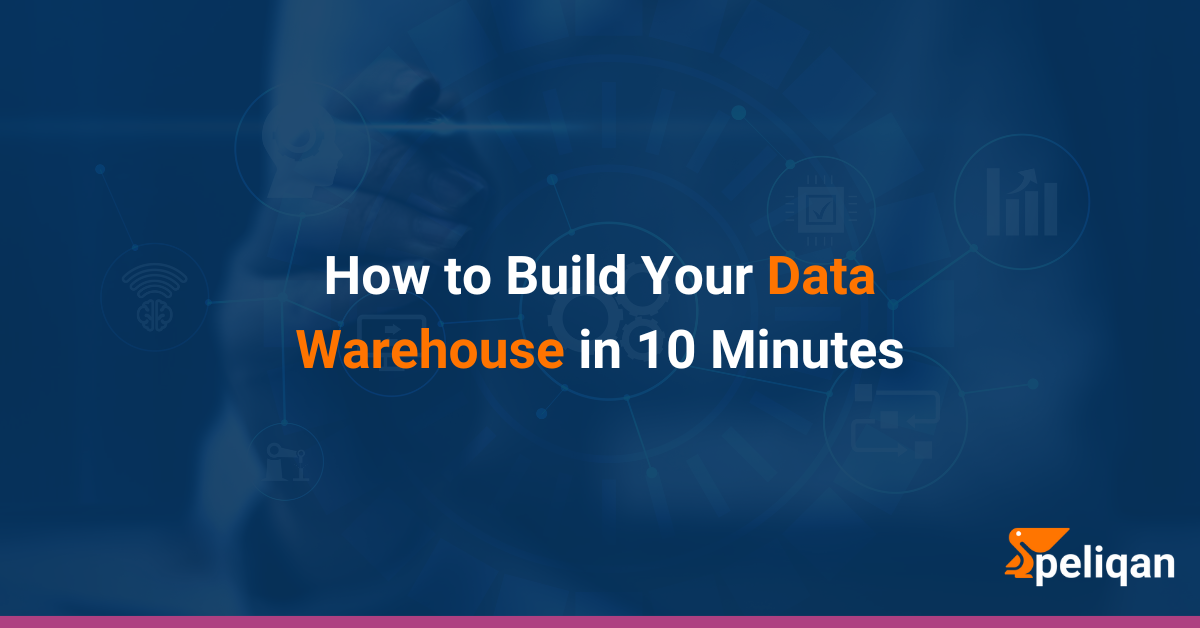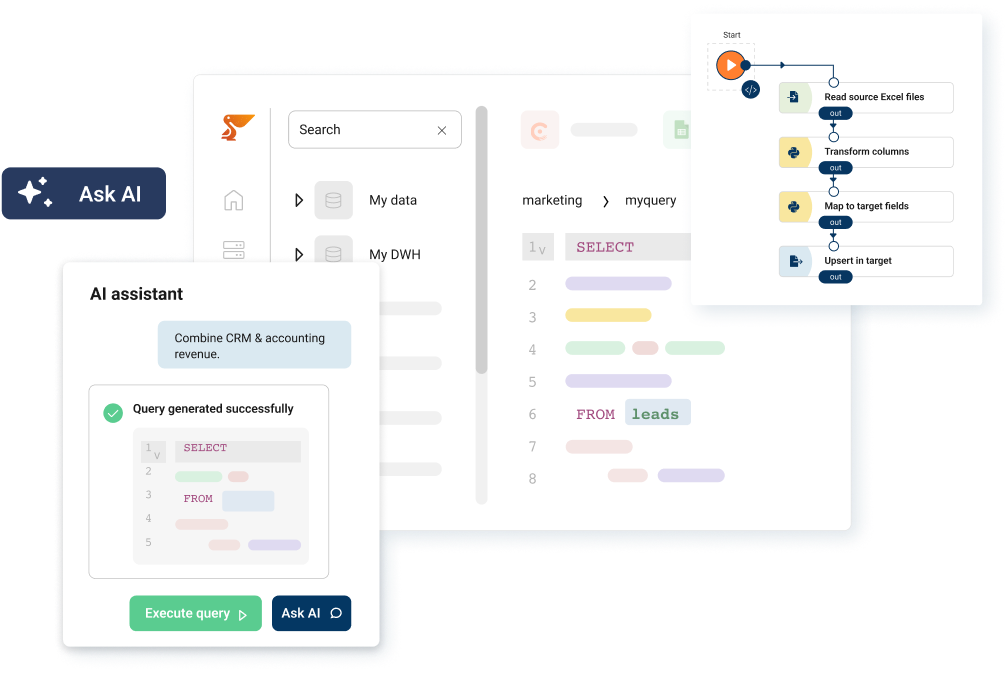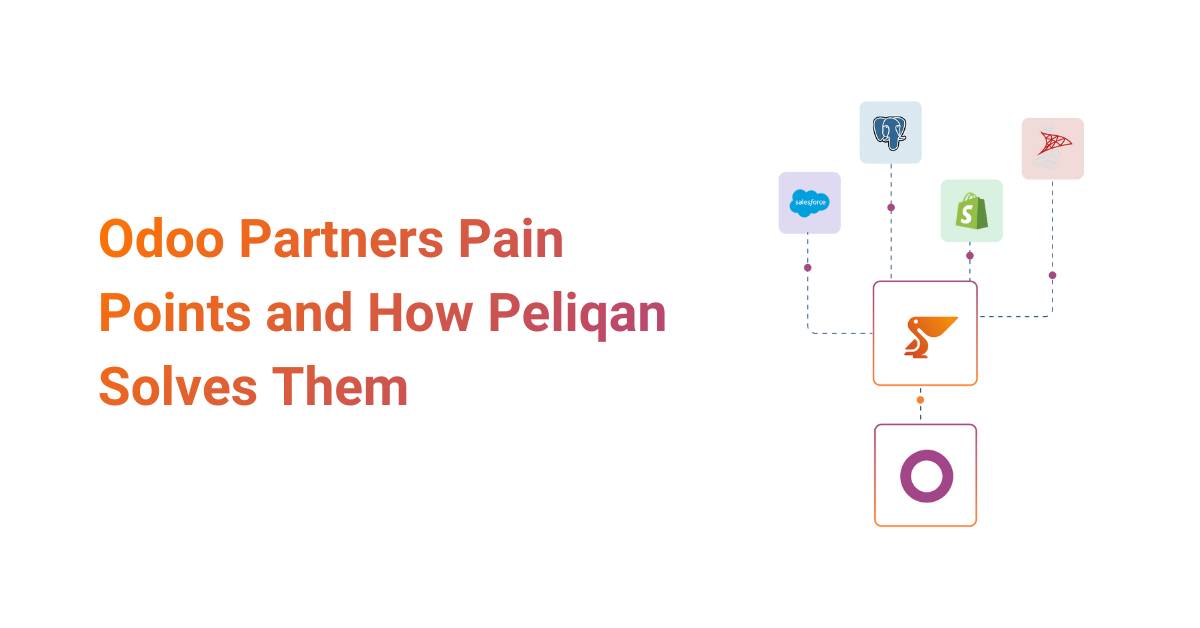In today’s data-driven world, businesses rely heavily on the insights derived from their data to make informed decisions, optimize processes, and gain a competitive edge. Setting up a robust data warehouse is a crucial step towards harnessing the power of data effectively.
However, traditional data warehouse setup processes can be complex, time-consuming, and require specialized skills.
This article will guide you through the steps to set up a simple data warehouse in just 10 minutes. Whether you’re a seasoned data professional or new to data management, this guide will provide you with the insights you need to get started. To effectively harness the power of data warehousing, it’s crucial to understand the foundational elements that underpin its structure and functionality.
Concept of Data Warehousing
Data warehousing is a systematic approach to managing data that entails the collection, storage, and eventual retrieval of large volumes of information generated from diverse sources. At its core, a data warehouse serves as a centralized repository where data is consolidated, transformed, and structured to support analytical reporting and business intelligence activities.
The architecture of data warehousing typically involves various layers, including data extraction, transformation, and loading (ETL) processes, which ensure that the data is cleansed and integrated before being stored in the warehouse. This structured approach not only facilitates efficient data querying and analysis but also enhances the overall decision-making process by providing stakeholders with timely access to meaningful insights derived from historical data.
Understanding the concept of data warehousing is fundamental, but it is equally important to explore the key advantages it provides, which can significantly enhance an organization’s data management capabilities and strategic decision-making processes.
The Importance of Building a Data Warehouse
Building a data warehouse is vital for organizations aiming to leverage their data effectively. The importance of creating a robust data warehouse can be understood through the following points:
- Enhanced Decision-Making: A well-structured data warehouse consolidates data from various sources, allowing decision-makers to access comprehensive datasets, which leads to more informed and timely decisions.
- Improved Data Quality: The ETL process ensures that the data being fed into the warehouse is cleansed and standardized, significantly reducing errors and increasing the reliability of the information used for analysis.
- Historical Insight: Data warehouses enable the storage and analysis of large volumes of historical data, enabling organizations to identify trends over time, aiding strategic planning and forecasting.
- Faster Query Performance: By optimizing data storage and implementing performance improvement techniques, a data warehouse ensures that complex queries can be executed quickly, facilitating rapid data retrieval and analysis.
- Support for Business Intelligence: A data warehouse serves as the backbone for business intelligence tools, empowering users to create meaningful reports, dashboards, and visualizations that drive business insights.
- Scalability and Flexibility: As data volumes grow, a well-designed data warehouse can scale to accommodate increasing amounts of data without compromising performance or analytical capabilities.
- Regulatory Compliance: Building a data warehouse allows for better data governance, helping organizations manage data in compliance with regulatory requirements, such as GDPR or NIS2, enhancing security and data integrity.
Steps to Build a Data Warehouse
We’ll explore real-world examples and showcase how Peliqan, an all-in-one data platform, can simplify the process and turn you into a data-driven decision-making powerhouse.
Define Your Needs
Before diving into the technical aspects, it’s crucial to define your data warehouse goals. What specific information do you need to gather and analyze? What business questions are you hoping to answer? Here are some data-driven questions you might consider:
- Marketing: How effective are our marketing campaigns across different channels? What is our customer acquisition cost (CAC)?
- Sales: What are the key factors influencing our sales pipeline? How can we improve our lead nurturing process?
- Finance: What are our key financial metrics (e.g., revenue, churn rate, profit margins)? How can we optimize our cash flow management?
- Operations: What are our operational bottlenecks? How can we improve efficiency and reduce costs?
Clearly defining your objectives will guide your data selection and ensure your warehouse caters to your specific needs.
Choose Your Deployment Option
Gone are the days of lengthy on-premise installations. Today, cloud-based data warehouses offer a plethora of benefits:
- Scalability: Easily adapt to growing data volumes without expensive hardware upgrades.
- Cost-Effectiveness: Pay-as-you-go pricing eliminates upfront infrastructure costs.
- Accessibility: Access your data from anywhere with an internet connection.
- Security: Leverage robust security features provided by cloud providers.
Peliqan provides the option to utilize its built-in data warehouse or seamlessly integrate with popular cloud data warehouses like Snowflake and BigQuery. This flexibility allows you to choose the platform that best suits your existing infrastructure and scalability requirements.
Connect Your Data Sources
Data often resides in various sources, making accessibility and integration crucial. Peliqan simplifies data ingestion by offering pre-built connectors for over 100+ SaaS applications, databases, and file formats. This eliminates the need for manual coding, allowing you to effortlessly connect to all your relevant data sources within minutes.
Imagine a SaaS company like Skindr, a platform connecting users with dermatologists. Skindr utilizes Peliqan to centralize marketing data from HubSpot, Helpscout, app download data from Apple App Store and Google Play Store, and seamlessly combines and transforms this data for further analysis. This unified view allows Skindr’s CMO to gain valuable insights into marketing effectiveness and customer acquisition strategies.
Transform Your Data (ETL)
Extracting, transforming, and loading (ETL) data involves cleaning, organizing, and preparing your data for analysis. Peliqan’s intuitive interface allows you to visually define your data transformations without writing complex code. This streamlines the process and ensures your data is ready for further exploration.
Consider Horsum, a company specializing in operational and finance process improvement. Peliqan serves as their central data hub, connecting their accounting software and enabling multi-customer management. This streamlined data flow allows Horsum to generate insightful reports and dashboards using Power BI, ultimately helping their clients optimize their business processes.
Activate Your Data
Data in its raw form holds immense potential, but true value lies in activating the data. Peliqan empowers you to leverage your data through various functionalities:
- Alerts & Reports: Set up automated alerts to notify you of critical events or generate insightful reports for data-driven decision-making.
- Reverse ETL: Push data back into your operational systems to automate tasks or personalize user experiences.
- Data APIs: Expose your data securely through APIs, enabling integration with other applications and tools.
- Machine Learning Models: Leverage your data to train and deploy machine learning models for predictive
- LLM Chatbots: Build and integrate intelligent chatbots powered by large language models (LLMs) to enhance user engagement and automate tasks.
Top Data Warehouse Management Techniques
Managing a data warehouse requires careful planning and monitoring. There are several strategies that can help you optimize your data warehouse and ensure its efficiency. Here are some top techniques for managing your data warehouse:
- Use a data management system to automate tasks like data backup, replication, and recovery.
- Implement a data archiving system to store older data that is not frequently used.
- Monitor data usage patterns and adjust as needed to ensure optimal performance.
- Use data deduplication techniques to remove duplicate data and reduce storage space requirements.
By following these best practices, you can ensure that your data is organized, accessible, and secure. This will help you optimize your data storage and management processes, leading to improved performance and efficiency.
Common Data Warehouse Challenges and Solutions
When working with large data sets, there are several challenges that can arise. These challenges can impact performance, data quality, and accuracy. However, there are several solutions that can help overcome these challenges. Here are some common data warehouse issues and solutions:
- Data quality issues can be resolved through data cleansing techniques.
- Performance issues can be addressed by optimizing queries and indexing.
- Synchronization issues can be resolved with data integration tools.
By understanding these common issues and implementing solutions, you can ensure that your data warehouse is running smoothly and efficiently.
Data Warehouse Examples
Let’s delve deeper into some real-world data warehouse examples:
Globis, a logistics platform, utilizes Peliqan to build a data warehouse, integrating ERP and weather information to predict delays in sea ship container arrivals. It then activates this data by pushing insights back into operational systems, allowing for proactive adjustments and improved efficiency.
CIC hotels, managing 40+ hotels with diverse software, uses Peliqan to build a finance data warehouse by connecting accounting and hotel ERP systems. Peliqan’s SQL transformation capabilities ensure accurate data unification, and the platform allows for writeback to Google Sheets, enabling the group CFO to generate consolidated monthly reports effortlessly.
Heylog, a logistics communication software company, uses Peliqan as their white-labelled data platform. Peliqan connects to over 15 TMS and communication platforms, facilitating data pipelines and writeback functionalities. This empowers Heylog to monitor and improve their TMS system, capture live location information, and share it seamlessly with drivers and partners.
These examples showcase the diverse applications of data activation and how Peliqan empowers businesses to transform raw data into actionable insights that drive real-world results.
Peliqan: Build Your Own Data Warehouse

Peliqan offers comprehensive solutions tailored to meet the unique needs of businesses seeking to optimize their data management processes. With a focus on scalability, performance, and security, Peliqan provides a robust platform for data warehousing that ensures seamless integration, enhanced analytics, and effective data governance. Peliqan simplifies data warehouse setup for businesses of all sizes:
- No Data Engineer Needed: Peliqan’s intuitive interface and pre-built functionalities eliminate the need for extensive technical knowledge, making data warehousing accessible to everyone.
- Low-Code Environment: Combine the power of SQL with the ease of low-code Python to implement complex data transformations and workflows without extensive coding.
- Scalability and Security: Peliqan scales seamlessly with your data volume and growth, ensuring your platform remains secure and reliable.
- White-Labeling: Peliqan empowers consultants, ISVs, and agencies to offer data warehousing solutions under their own brand, enabling them to cater to their clients’ specific needs.
To further illustrate the advantages of using Peliqan for building your enterprise data warehouse, let’s compare it with traditional data warehouse solutions:
| Feature | Peliqan | Traditional Data Warehouse Solutions |
|---|---|---|
| Setup Time | 10 minutes | Weeks to months |
| Technical Expertise Required | Minimal – user-friendly interface | High – requires data engineering skills |
| Pre-built Connectors | 100+ SaaS and database connectors | Limited or requires custom development |
| Scalability | Automatic scaling | Manual scaling, often requires infrastructure changes |
| Data Transformation | Visual interface, low-code environment | Complex ETL processes, often requires coding |
| Cost | Pay-as-you-go, optimized for efficiency | High upfront costs, ongoing maintenance expenses |
| Integration with BI Tools | Seamless integration with popular BI tools | May require additional connectors or custom integration |
| Data Activation | Built-in features for alerts, reverse ETL, and ML integration | Often requires additional tools or custom development |
| White-labeling Options | Available for consultants and agencies | Typically not available |
| Maintenance | Managed service with automatic updates | Requires dedicated team for maintenance and updates |
As the table demonstrates, Peliqan offers significant advantages in terms of speed, ease of use, and built-in functionality compared to traditional data warehouse solutions. These benefits make it an excellent choice for businesses looking to quickly implement a robust data warehouse without the need for extensive technical resources or long development cycles.
By choosing Peliqan for building your data warehouse, you can accelerate your journey to becoming a data-driven organization, allowing you to focus on deriving insights and value from your data rather than getting bogged down in complex technical implementations.
Ready to experience the Peliqan difference? Sign up for a free Peliqan trial today and build your data warehouse in minutes!
Remember, Peliqan is not just a tool; it’s a journey towards becoming a data-driven organization. Partner with Peliqan and embark on your path to data-driven success!





